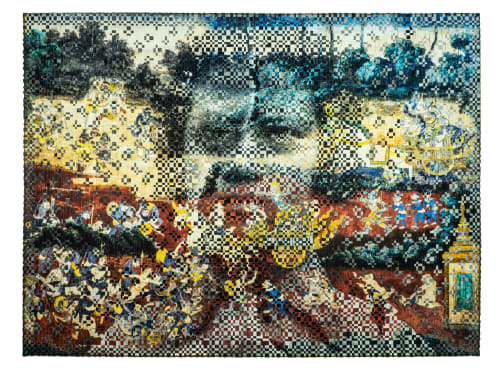In Cambodia Reamker, Dinh Q. Lê features new photographic weavings depicting the Reamker, Cambodia’s version of the Ramayana, interwoven with portraits of prisoners from the Khmer Rouge’s notorious prison, Tuol Sleng.
Born in Ha Tien, a border town between Vietnam and Cambodia, Lê has long been interested in Cambodia’s recent history. In 1978, when the Khmer Rouge invaded and massacred many residents of Ha Tien, the artist’s family was forced to flee, first to Thailand and then finally to the United States. For many years, the artist has worked with the portraits of people who were tortured and killed by the Khmer Rouge. Dissatisfied with how these portraits depict the imprisoned individuals—at their worst and last moments—Lê’s artworks offer an alternative narrative drawn from Cambodia’s rich history.
To make these weavings, the artist starts with his own photographs of the elaborate murals at the Cambodian Royal Palace in Phnom Penh. Depicted in these paintings is the Reamker, Cambodia’s interpretation of the Sanskrit Ramayana, an epic poem about the balance between good and evil. Though now deteriorating, these beautiful murals illustrate the rich culture of Cambodia, a once-dominant empire in Southeast Asia. Intertwined with scenes from the murals are close-cropped portraits of prisoners from Tuol Sleng. Though Lê has worked with this subject matter before, he has removed all visual reference to them as prisoners so that the viewers can relate to the subjects as individuals whose lives embodied more than their victimhood.
The result for Lê is a new body of work that physically interlaces these two narratives from the past—the rich cultural legacy of the Cambodian empire and the more recent, tragic history of the Khmer Rouge—in a way that is evocative of the Reamker itself, a metaphorical tale of the complex push-pull between good and evil in the world.
Born in Ha Tien, a border town between Vietnam and Cambodia, Lê has long been interested in Cambodia’s recent history. In 1978, when the Khmer Rouge invaded and massacred many residents of Ha Tien, the artist’s family was forced to flee, first to Thailand and then finally to the United States. For many years, the artist has worked with the portraits of people who were tortured and killed by the Khmer Rouge. Dissatisfied with how these portraits depict the imprisoned individuals—at their worst and last moments—Lê’s artworks offer an alternative narrative drawn from Cambodia’s rich history.
To make these weavings, the artist starts with his own photographs of the elaborate murals at the Cambodian Royal Palace in Phnom Penh. Depicted in these paintings is the Reamker, Cambodia’s interpretation of the Sanskrit Ramayana, an epic poem about the balance between good and evil. Though now deteriorating, these beautiful murals illustrate the rich culture of Cambodia, a once-dominant empire in Southeast Asia. Intertwined with scenes from the murals are close-cropped portraits of prisoners from Tuol Sleng. Though Lê has worked with this subject matter before, he has removed all visual reference to them as prisoners so that the viewers can relate to the subjects as individuals whose lives embodied more than their victimhood.
The result for Lê is a new body of work that physically interlaces these two narratives from the past—the rich cultural legacy of the Cambodian empire and the more recent, tragic history of the Khmer Rouge—in a way that is evocative of the Reamker itself, a metaphorical tale of the complex push-pull between good and evil in the world.


